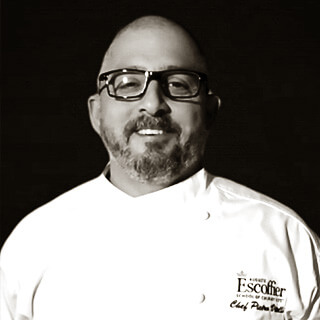When was the last time you had a dish that really spoke to you—that made you think, “Wow, now that was special”?
As a chef, creating those new experiences through your food can be one of the greatest challenges—and joys. But with so many variables involved in creating a new dish—from flavors and ingredient selection to preparation and technique—how do you know where to start?
While the process of coming up with new dishes can seem daunting, there are some steps that can make it easier to approach. For an inside look at how to create new recipes, let’s explore what can go into the creative process with some observations from Escoffier Chef Instructor Pietro Vitelli regarding his own approach to culinary invention.
Taste Everything: Understanding Flavor and Texture
Whether you’re an experienced chef or an aspiring culinarian, building familiarity with a broad range of flavors is among the most important skills you can develop. The broader your knowledge of flavor, the more options you’ll have when creating new dishes.
Build Your Flavor Bank: Exploring the Nuances
“We have in our minds what’s called this flavor bank,” says Chef Pietro, “and all these flavors start to store up inside of them.”* Building up that flavor bank can allow you to better understand the relationships between flavors and discover new ways to weave them together.
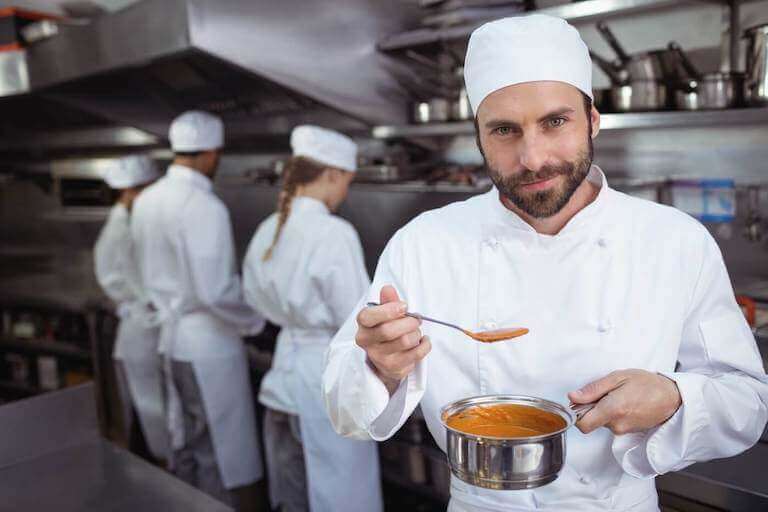
Understanding the fundamentals of flavor can enable you to create inventive new dishes.
The best way to do this? “Taste everything. Taste everything you can—whether you like it or not, it doesn’t matter. The importance of that is, you can understand textures and flavors—things that you’ve never tasted, even things that you thought would never work.”* As you add to your flavor bank, you can then take those experiences home and try to replicate them in your own kitchen—and once you’ve figured out how to replicate a flavor yourself, it becomes another resource in your culinary toolbox.
Wield the Tasting Spoon: Testing as You Cook
This approach doesn’t just apply to tasting other people’s finished dishes—you can also learn a lot about flavors by tasting your own food while cooking. This practice is a part of Chef Pietro’s own creative process. “Taste the raw item before you start to cook it,” he says. “Understand what that tastes like. Say you’re making a sauce, and you’ve got to sweat out some carrots and onions. Taste them while they’re sweating—get a spoon and see what they taste like when they start to soften up. And then once they’re fully sweated out, taste those vegetables. Know what that layer is all about.”*
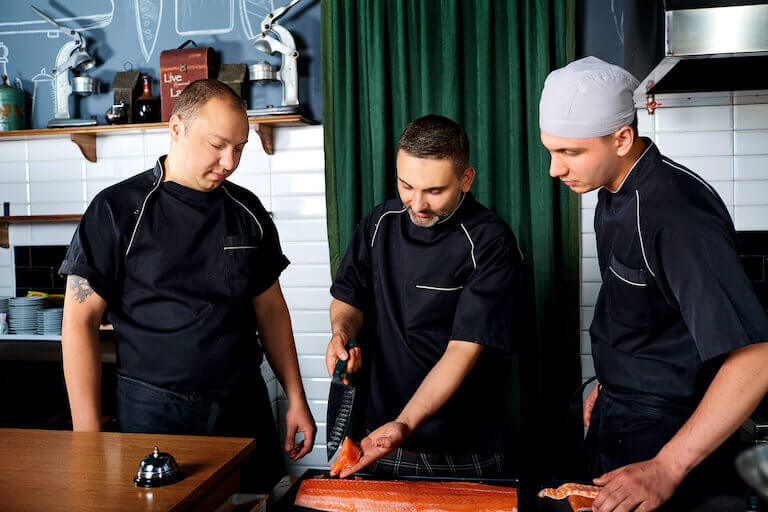
Getting to know how ingredients change while cooking could help you discover creative ways to use them.
Doing this gives you the opportunity to fully understand the transformation taking place with your ingredients, which can give you a stronger foundation when thinking about how to incorporate those ingredients into new dishes.
Let Your Ingredients Guide You: Adapting to What You Have
It’s also important to taste the ingredients you have available to you and let them suggest how they should be used. The same ingredient may vary in quality, ripeness, and flavor, depending on its source. Embracing the variability of ingredients can inspire you to come up with new ways to showcase their unique flavors through your cooking.
This can be especially true when working with fresh, seasonal ingredients. As a chef, you can build up relationships with local farmers and artisans to anticipate what ingredients you may have access to and come up with dishes that can allow your guests to experience the full depth of those ingredients’ flavors.
Embrace the Process of Dish Creation
The process of creating new dishes can start long before you actually sit down to hash out an idea. In the same way that you may rely on the flavor bank that you’ve built up over time, you’re also likely to lean on the technical skills you’ve developed over your cooking career. And the more skills you have at your disposal, the more free you can be to let your creativity shine.
Take the Time to Hone Techniques
When creating new dishes, Chef Pietro believes in the importance of dedication to technique. At one of the restaurants he once worked at, he made the same recipe for gravlax, or cured salmon, every week for a whole year. In doing so, the process became second nature to him. When the restaurant brought in two additional types of salmon—a White and Red King Salmon—he knew exactly what he wanted to do. With three different colors of salmon on the plate now, why not have three different flavors?
Having established the fundamental technique, he found that he was able to focus on the flavors that he wanted to incorporate; rather than having to reinvent the wheel, he could instead let the flavors and ingredients do the talking. He introduced a sambuca-basil cure for one of the new types of salmon—a flavor combination he had always wanted to try and now had the opportunity to work with thanks to the availability of the ingredients and his knowledge of the technique.
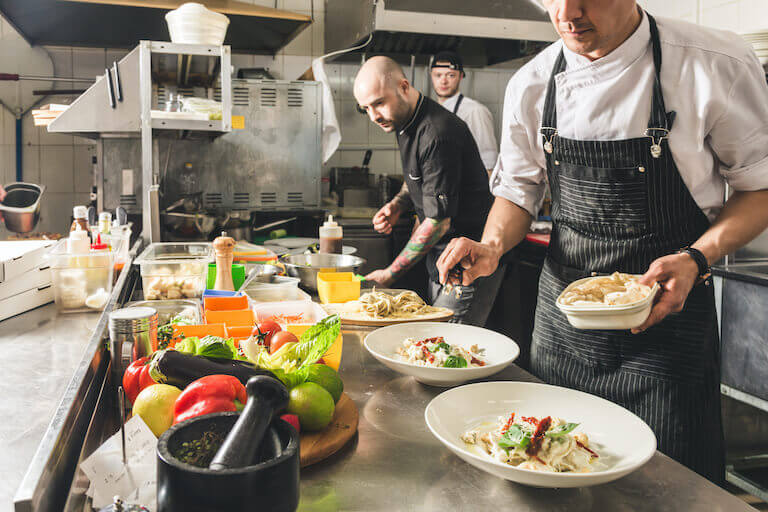
A strong understanding of technique can provide a foundation for creativity.
Never Stop Growing
Instead of thinking about the new dishes you create as your ultimate goal, you may want to instead try considering them as byproducts of a lifelong process of culinary growth. There’s always more to discover whenever you step into a kitchen, whether that be at home, while working in a restaurant, or even attending culinary school – an experience that can hold value for both newer cooks and seasoned chefs alike. Along this journey, the discoveries you make may inspire you to create new dishes.
Some dishes will need to simmer in your mind for a while before you’re ready to perfect them. Others may take a lot of trial and error before you find that final piece that makes everything fall into place. Get comfortable with failure and with going back to the drawing board, and always write down your ideas, even if they’re not fully formed or the ingredients to execute them aren’t available.
It can also be helpful to embrace input from your fellow chefs. Chef Pietro always makes a point of talking with his peers about the dishes he’s working on, and he sees it as a great opportunity to get feedback and to draw on the experiences of others. “You have to be very open and very humble to take in criticism and information from others…Sometimes it’s not easy. But I’m not the goal. Who’s the goal? It’s the plate, and it’s the guest.”* Taking a learning mindset can help you acquire the skill you may need to take your cooking—and the new dishes you create—to the next level.
Cook What Inspires You
With so many possible combinations of flavors and culinary techniques, how do you know where to begin when you sit down to try to create a new recipe? For some, drawing inspiration from touchstones—whether they be classic dishes or food memories from one’s own past—can be a helpful starting point.
Revisit the Classics
“I revisit the classics a lot,” says Chef Pietro. “And I’ve come to understand that, if we look at how people eat, everybody still likes the classics…Our goal as chefs is, how do we do something different with that?”* When it comes to classic dishes, they’re usually popular for a reason. There are certain combinations that just go together. Exploring the reasons why these dishes work can be a great way to come up with new combinations of your own.
When evaluating a classic dish, try probing what it is about the flavors, textures, and presentation that makes it so successful. Once you’ve identified those things, you can then take the process a step further by thinking about new ways to showcase those unique qualities. The discoveries you make during this process may become the foundations of a new dish based on culinary combinations that you know are successful, with a preparation and presentation that’s all your own.
Cook Your Memory
You don’t necessarily need to reach for classic recipes to put this strategy into practice; sometimes, you can go straight to your culinary roots and revisit the flavors and food experiences that made you who you are. As Chef Pietro puts it, “I cook my memory”*—specifically the flavor memories that bring him back to his Italian upbringing, where the kitchen was the living room and somebody was always cooking.
This was the approach he took when creating one dish he looks on particularly fondly—an oxtail croquette with minted tomatoes and crispy peas. It’s inspired by his mother’s braciola and braised beef shank studded with mint-wrapped garlic and braised in an onion broth. When thinking about how to reinvent this dish, he concerned himself not only with getting the flavors and textures right, but also doing justice to his childhood memory of it. He also found that his familiarity with the way the dish was traditionally prepared helped him recognize when his version of it was working.
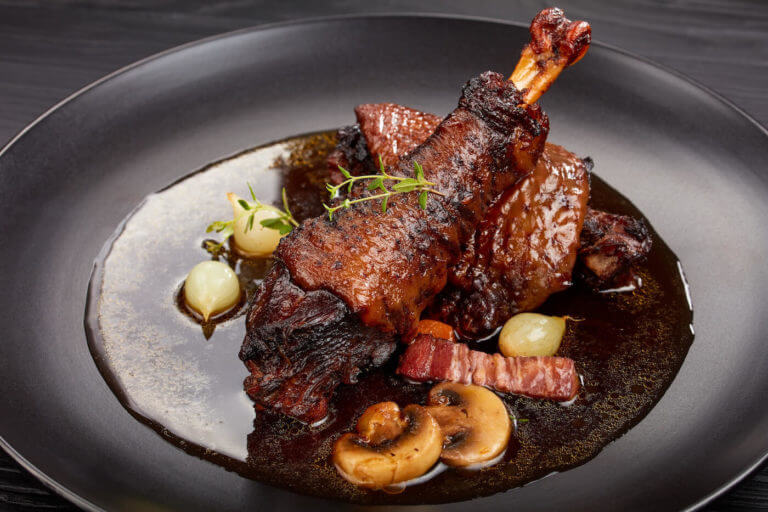
Traditional dishes can provide inspiration for creating new ones.
“I knew when that braise was done based on my memory of when I had it, how it made me feel, what it smelled like, what it tasted like. [Even though] I was taking it to a different level, I also knew what I was looking for in the minted tomatoes and the crispy peas; as long as those were met there, when you put the whole thing together, you know it was going to be good.”*
Going back to the dishes you grew up with—and maybe even inspired you to pursue a culinary career—can be a great way to draw on food memories that are deeply embedded in your flavor bank and techniques that you may have carried with you for years.
Are You Ready to Explore Your Culinary Creativity?
Creating new dishes may be one of the most exciting parts of being a chef. It involves pushing your understanding of flavors and techniques and drawing on food traditions to develop something that’s uniquely your own.
But even though a dish may be your creation, it’s hard to get there alone. Surrounding yourself with knowledgeable, experienced chefs can be a great way to soak up new approaches to cuisine and take your culinary creativity to the next level. Enrolling in one of Escoffier’s programs—either at our Austin or Boulder campuses, or online—can give you the opportunity to work with both peer culinarians and seasoned Chef Instructors while being exposed to new flavors and techniques.
Financial aid, grants, and scholarships are available to those who apply and qualify, which can help bring you that much closer to realizing enrollment in culinary school.
INTERESTED IN LEARNING MORE ABOUT CULINARY CREATIVITY? HERE ARE A FEW MORE SUGGESTIONS!
- How Building a Personal Brand Can Benefit Your Culinary Career
- How to Create Unforgettable Food Memories – Executive Chef Lee Hillson
- 5 Experiences That All Great Chefs Should Have

